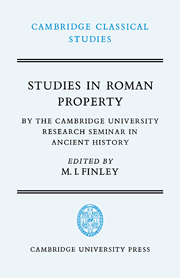Book contents
- Frontmatter
- Contents
- Preface
- 1 INTRODUCTION
- 2 SOME CONFIGURATIONS OF LANDHOLDING IN THE ROMAN EMPIRE
- 3 IMPERIAL ESTATES
- 4 CLASSICAL ROMAN LAW AND THE SALE OF LAND
- 5 THE CICERONIAN ARISTOCRACY AND ITS PROPERTIES
- 6 PRIVATE FARM TENANCY IN ITALY BEFORE DIOCLETIAN
- 7 URBAN PROPERTY INVESTMENT
- 8 AGRI DESERTI
- Notes
- Bibliography
- Index
8 - AGRI DESERTI
Published online by Cambridge University Press: 05 June 2014
- Frontmatter
- Contents
- Preface
- 1 INTRODUCTION
- 2 SOME CONFIGURATIONS OF LANDHOLDING IN THE ROMAN EMPIRE
- 3 IMPERIAL ESTATES
- 4 CLASSICAL ROMAN LAW AND THE SALE OF LAND
- 5 THE CICERONIAN ARISTOCRACY AND ITS PROPERTIES
- 6 PRIVATE FARM TENANCY IN ITALY BEFORE DIOCLETIAN
- 7 URBAN PROPERTY INVESTMENT
- 8 AGRI DESERTI
- Notes
- Bibliography
- Index
Summary
Whatever one's view of the ultimate cause of the fall of the Roman empire, land and more specifically the decline of productivity on the land always figure more or less prominently within an assessment of the social and political changes that were taking place. Even Jones, who has expressed far more reserve about general theories of decline than most, gave as his opinion that the devastation of the land and its subsequent desertion grew worse from the third century A.D. to the sixth. In other words, agri deserti are to be regarded as a malignant growth of the later Roman Empire, with a datable origin into the bargain.
The problems involved in making objective judgements about this, as about so many other subjects in the period, are too well known to need much repetition. But they are essentially methodological. That is to say, the sources are atrocious and there is a constant temptation to generalize from inadequate data – a limitation which applies with particular force to the third century during which the decline is supposed to have begun and with which this chapter is chiefly concerned. So it is worth stating clearly at the outset a few observations on the nature of the evidence.
- Type
- Chapter
- Information
- Studies in Roman PropertyBy the Cambridge University Research Seminar in Ancient History, pp. 137 - 166Publisher: Cambridge University PressPrint publication year: 1976
- 47
- Cited by

